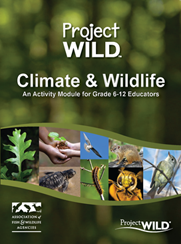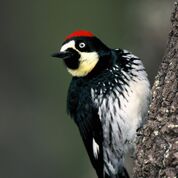Teaching about climate change is a challenge. Project WILD materials and training can help!
Using wildlife as an integrating context helps make teaching about climate change more concrete. Use best practices in climate change education and gain access to quality, science-based, wildlife management principles that address this complicated issue. Your students will be outdoors, interacting with one another and the community, and learning from trusted sources.
Using Project WILD to Teach about Climate Change
Project WILD activities are ideal for exploring subjects that are complex and interdisciplinary. Using simulations and systems thinking, students explore the ecological, social, and economic aspects of environmental issues and phenomena. They work collaboratively to understand and articulate multiple viewpoints and stakeholder interests in order to find constructive actions geared toward environmental stewardship. The resources listed below will help educators select and implement Project WILD activities as part of their climate change education curriculum.
project Wild: Climate & wildlife
Formal and nonformal and nonformal educators can now receive professional development training that focuses specifically on integrating topics on Climate Adaptation into their curriculum. As part of the training, educators will receive the 64-page booklet titled Climate & Wildlife: An Activity Module for Grades 6-12 Educators. This resources features a collection of eight activities from Project WILD publications that connect closely to the the National Fish, Wildlife, and Plants Climate Adaptation Strategy.
The activities include content on the following subject matter:
• Shifting phenology and ranges,
• Interdependence of species,
• Balancing ecological, cultural, recreational, and commercial uses of land and resources,
• Community messaging and engagement,
• Assessing species vulnerability, and
• Reducing non-climate stressors to species and ecosystems.
Professional development for using the Climate & Wildlife module began in some states: Kansas, New Hampshire, Ohio, Oregon, and Texas. Additionally, the Association of Fish & Wildlife Agencies is now offering a self-paced online course for educatrors on Climate & Wildlife. See the page on Project WILD's online courses to learn more.
To inquire about Climate & Wildlife professional development training opportunities in your state, contact your Project WILD State Coordinator.
To purchase a copy of the Climate and Wildlife Module, go to the Project WILD Online Store.

National fish, wildlife, and Plants climate adaptation strategy
The Strategy describes eight goals that help federal, state, and tribal agencies collaborate and adapt management practices for species and landscapes impacted by climate change. These goals also provide a framework for student learning about climate adaptation.
For links to the Strategy, a fact sheet, and other related resources, visit the National Fish, Wildlife, and Plants Climate Adaptation Network page.
"You can't go back and change the beginning,
but you can start where you are and change the ending." ~ C.S. Lewis

Acorn woodpecker. Photo credit: George Andreiko, Arizona Game & Fish
Make it Happen!
- Find a Project WILD Coordinator near you.
- Take part in an an amazing workshop, where you'll learn about local educator resources.
- Take action! Create a habitat on your school site: build nest boxes, conduct a stream clean-up, or plant native plants.
Resources
- View our webinar on Wildlife and Climate Change
- For crowd-sourced resources on climate change in your state, visit: https://padlet.com/projectwild/climate
- Check out the Wildlife, Weather, & Climate Change Module from North Carolina State University.
- View these Project WILD, Project WET, and Project Learning Tree activities related to climate change.
- See The Essential Principles of Climate Literacy from the National Oceanic and Atmospheric Administration.
- Conservation, COVID-19, and Climate Change Webinar.
